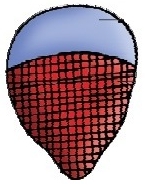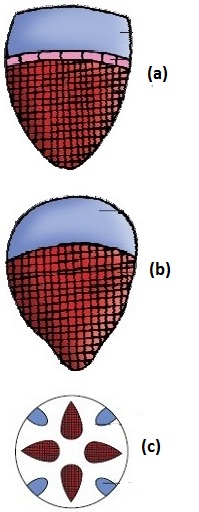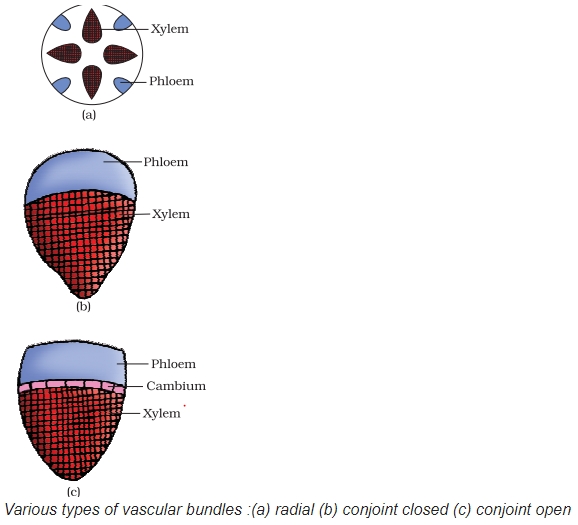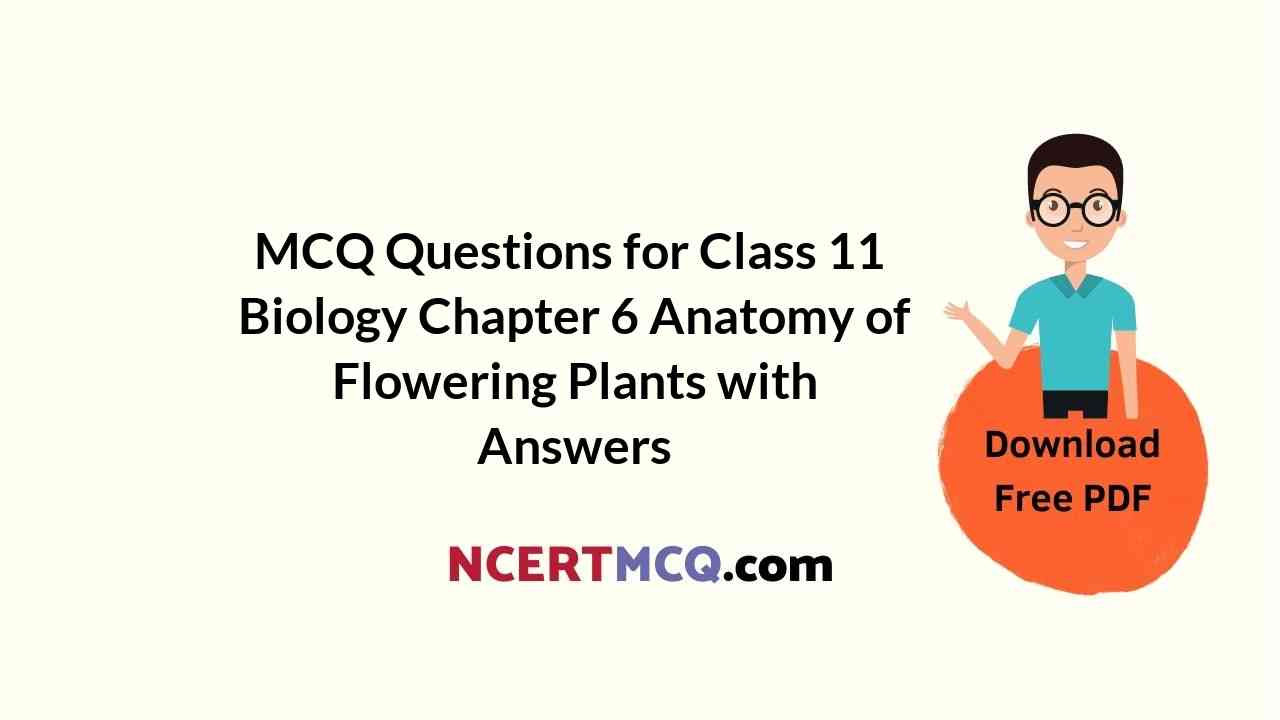Check the below NCERT MCQ Questions for Class 11 Biology Chapter 6 Anatomy of Flowering Plants with Answers Pdf free download. MCQ Questions for Class 11 Biology with Answers were prepared based on the latest exam pattern. We have provided Anatomy of Flowering Plants Class 11 Biology MCQs Questions with Answers to help students understand the concept very well.
Class 11 Biology Chapter 6 MCQ With Answers
Biology Class 11 Chapter 6 MCQs On Anatomy of Flowering Plants
Anatomy Of Flowering Plants Class 11 MCQ Question 1.
Quiescent centre is present in the
(a) apical meristem
(b) shoot meristem
(c) lateral meristem
(d) root meristem
Answer
Answer: (d) root meristem
Class 11 Biology Chapter 6 MCQ Question 2.
Closed vascular bundles lacks
(a) pith
(b) xylem
(c) cambium
(d) xylem vessels
Answer
Answer: (c) cambium
Explanation:

Picture of closed conjoint vascular bundles.
Anatomy Of Flowering Plants MCQ Question 3.
Which of the following is not a feature of spring wood?
(a) Color of the wood is light.
(b) Density is less.
(c) Cambium is active.
(d) Lesser number of xylary elements.
Answer
Answer: (d) Lesser number of xylary elements.
Explanation:
Spring season produces a wood which has large number of xylary elements having vessels with wider cavities.
MCQs Of Biology Class 11 Chapter 6 Question 4.
In a monocot leaf
(a) bulliform cells are absent from the eqidermis
(b) veins from a network
(c) mesophyll is well differentiated into palisade and spongy parenchyma
(d) mesophyll is not differentiated into palisade and spongy parenchyma
Answer
Answer: (d) mesophyll is not differentiated into palisade and spongy parenchyma
MCQ Questions For Class 11 Biology Chapter 6 Question 5.
A.T.S. of a young dicot root can be distinguished from that of a young dicot stem by the presence of
(a) radial arrangement of xylem and phloem
(b) collateral arrangement of xylem and phloem
(c) interfascicular cambium
(d) intrafascicular cambium
Answer
Answer: (a) radial arrangement of xylem and phloem
Chapter 6 Biology Class 11 MCQs Question 6.
Fusifrom initial cells of cambium from
(a) vascular rays
(b) tracheary elements
(c) ray parenchyma
(d) phloem parenchyma
Answer
Answer: (b) tracheary elements
MCQ On Anatomy Of Flowering Plants Class 11 Question 7.
Callose deposition is found in
(a) tracheids
(b) companion cells
(c) sieve areas
(d) phloem parenchyma
Answer
Answer: (c) sieve areas
MCQ On Anatomy Of Flowering Plants Question 8.
Stem develops from
(a) radicle
(b) cotyledon
(c) mesocarp
(d) plumule
Answer
Answer: (d) plumule
Explanation:
Stem develops from plumule.
MCQ Of Anatomy Of Flowering Plants Question 9.
Stem grows in girth due to
(a) outer cortical
(b) epidermis
(c) vascular cambium
(d) phellogen
Answer
Answer: (c) vascular cambium
Explanation:
Stem increase in girth due to the activity of vascular cambium.
In this process, the outer cortical and epidermis layers gets broken.
This layer is replaced with new protective cell layer.
Biology Class 11 Chapter 6 MCQs Question 10.
Which of the following is true about heartwood?
(a) They are dead but gives mechanical support to stem.
(b) They are light in color.
(c) They conduct water and minerals.
(d) 1 and 3
Answer
Answer: (a) They are dead but gives mechanical support to stem.
Explanation:
Heartwood is dead and have non-conducting elements.
MCQs On Anatomy Of Flowering Plants Question 11.
Which picture shows conjoint closed vascular bundles?

(d) None of these pictures shows conjoint closed vascular bundles.
Answer
Answer: (b)
Explanation:

Ch 6 Bio Class 11 MCQ Question 12.
Pith is very well developed in
(a) monocot root and monocot srem
(b) monocot root and dicot root
(c) dicot root and monocot stem
(d) monocot root and dicot stem
Answer
Answer: (d) monocot root and dicot stem
Anatomy Of Flowering Plants MCQs Question 13.
Which of the following helps in the curling of the leaf surface?
(a) Bulliform cells
(b) Xylem tissue
(c) Palisade parenchyma
(d) Bundle sheath cells
Answer
Answer: (a) Bulliform cells
Explanation:
In grasses, adaxial epidermal cells along the veins modify themselves into large, empty, colorless cells. These are called bulliform cells.
When there is water stress leaves curl themselves inward to minimise water loss.
When the cells have absorbed water and are turgid, the leaf surface is exposed.
Anatomy Of Flowering Plants MCQ With Answers Question 14.
Walls of sclerenchyma are
(a) rigid
(b) lignified
(c) pectinised
(d) suberised
Answer
Answer: (b) lignified
Anatomy Of Flowering Plants Class 11 Ncert MCQ Question 15.
Fusifrom initial cells of cambium from
(a) vascular rays
(b) tracheary elements
(c) ray parenchyma
(d) phloem parenchyma
Answer
Answer: (b) tracheary elements
Question 16.
Closed vascular bundles lacks
(a) pith
(b) xylem
(c) cambium
(d) xylem vessels
Answer
Answer: (c) cambium
Question 17.
After the secondary growth, the oldest layer of secondary phloem in a dicot stem is located
(a) just outside the vascular cambium
(b) just inside the vascular cambium
(c) just inside the vascular phloem
(d) just outside the secondary xylem
Answer
Answer: (c) just inside the vascular phloem
Question 18.
The innermost layer of cortex which shows casparian thickenings in its cells is called as
(a) epidermis
(b) endodermis
(c) pericycle
(d) exodermis
Answer
Answer: (b) endodermis
Question 19.
Vessels differ from tracheids
(a) in being living
(b) in being derived from a single cell
(c) in that they consist of vertical row of cells with cross walls dissolved
(d) in coducting water and minerals
Answer
Answer: (c) in that they consist of vertical row of cells with cross walls dissolved
Question 20.
Endodermis cells are rich in
(a) cellulose
(b) starch grains
(c) fibers
(d) resins and wax
Answer
Answer: (b) starch grains
Explanation:
Endodermis cells are rich in starch grains.
We hope the given NCERT MCQ Questions for Class 11 Biology Chapter 6 Anatomy of Flowering Plants with Answers Pdf free download will help you. If you have any queries regarding CBSE Class 11 Biology Anatomy of Flowering Plants MCQs Multiple Choice Questions with Answers, drop a comment below and we will get back to you soon.
Class 11 Biology MCQ:
- The Living World Class 11 MCQ
- Biological Classification Class 11 MCQ
- Plant Kingdom Class 11 MCQ
- Animal Kingdom Class 11 MCQ
- Morphology of Flowering Plants Class 11 MCQ
- Anatomy of Flowering Plants Class 11 MCQ
- Structural Organisation in Animals Class 11 MCQ
- Cell: The Unit of Life Class 11 MCQ
- Biomolecules Class 11 MCQ
- Cell Cycle and Cell Division Class 11 MCQ
- Transport in Plants Class 11 MCQ
- Mineral Nutrition Class 11 MCQ
- Photosynthesis in Higher Plants Class 11 MCQ
- Respiration in Plants Class 11 MCQ
- Plant Growth and Development Class 11 MCQ
- Digestion and Absorption Class 11 MCQ
- Breathing and Exchange of Gases Class 11 MCQ
- Body Fluids and Circulation Class 11 MCQ
- Excretory Products and their Elimination Class 11 MCQ
- Locomotion and Movement Class 11 MCQ
- Neural Control and Coordination Class 11 MCQ
- Chemical Coordination and Integration Class 11 MCQ
